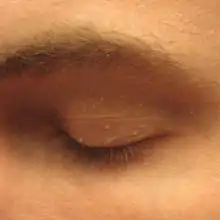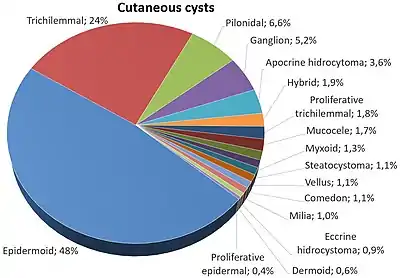Milium (dermatology)
| Milia | |
|---|---|
| Other names: Milk spot, oil seed | |
.jpg.webp) | |
| Milia | |
| Symptoms | Single or multiple small 1-2mm pearly-white bumps usually on face and and around eyes[1] |
| Usual onset | Any age[2] |
| Types | Neonatal, primary, juvenile, milia en plaque, traumatic, drug-induced[1] |
| Causes | Congenital, trauma, topical corticosteroids, dermabrasion, associated with DLE[2] |
| Diagnostic method | Visualisation, biopsy[1] |
| Differential diagnosis | Erythropoietic protoporphyria, mucinoses, lipoid proteinosis, adnexal tumors, primary systemic amyloidosis (adults)[3] |
| Treatment | Usually none,[1] laser therapy, dermabrasion, intense pulsed light, chemical peels, cryotherapy[3] |
| Frequency | Common[1] |
A milium (plural milia), is a small 1-2mm white bump in the skin of typically the face and around the eyes, which can appear on its own or more usually as several.[2] Types include neonatal, primary, juvenile, milia en plaque, traumatic, and drug-induced.[1] They are sometimes on the genitalia, often mistaken by those affected as warts or other sexually transmitted diseases. Milia can also be confused with stubborn whiteheads.
They can be congenital, triggered by trauma, topical corticosteroids or dermabrasion, or associated with discoid lupus erythematosus.[2] It is a clog of the eccrine sweat gland. It is a keratin-filled cyst that can appear just under the epidermis or on the roof of the mouth.[4][5]: 780
Milia are commonly associated with newborn babies but can appear on people of all ages.[6]: 680
In children, milia often but not always disappear within two to four weeks. For adults, they can be removed by a physician (a dermatologist will have specialist knowledge in this area). A common method that a dermatologist will use to remove a milium is to nick the skin with a #11 surgical blade and then use a comedone extractor to press the cyst out.[7]
.jpg.webp) Milia
Milia Milia
Milia Milia
Milia
See also
Epidemiology

References
- 1 2 3 4 5 6 "Milium". dermnetnz.org. Archived from the original on 15 August 2021. Retrieved 25 September 2021.
- 1 2 3 4 Johnstone, Ronald B. (2017). "16. Cysts, sinuses and pits". Weedon's Skin Pathology Essentials (2nd ed.). Elsevier. p. 338. ISBN 978-0-7020-6830-0. Archived from the original on 2021-05-25. Retrieved 2021-09-25.
- 1 2 Quist, Jennifer; Quist, Sven; Gollnick, Harold (2012). "48. Deposition diseases". In Bolognia, Jean L.; Jorizzo, Joseph L.; Schaffer, Julie V. (eds.). Dermatology. Vol. 1. Elsevier Health Sciences. pp. 712–714. ISBN 978-0-7234-3571-6. Archived from the original on 2021-09-25. Retrieved 2021-09-25.
- ↑ "milium" at Dorland's Medical Dictionary
- ↑ Freedberg, et al. (2003). Fitzpatrick's Dermatology in General Medicine. (6th ed.). McGraw-Hill. ISBN 0-07-138076-0.
- ↑ James, William D.; Berger, Timothy G.; et al. (2006). Andrews' Diseases of the Skin: Clinical Dermatology. Saunders Elsevier. ISBN 0-7216-2921-0.
- ↑ Burnett, Mark E.; Levitt, Jacob O. (2015). "Incision and Drainage (Abscesses, Acne, and Milia)". In Levitt, J.; Sobak, J. (eds.). Safety in Office-Based Dermatologic Surgery. Switzerland: Spring, Cham. pp. 119–128. doi:10.1007/978-3-319-13347-8_13.
| Classification | |
|---|---|
| External resources |
Template:Epidermal-growth-stub